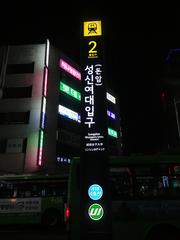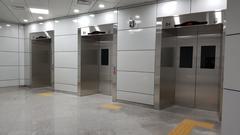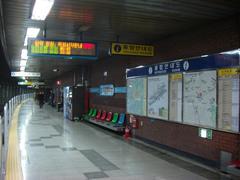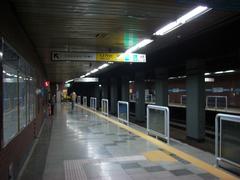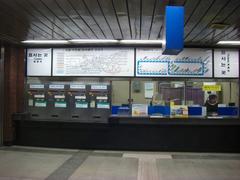
Sungshin Women’s University Station Visiting Guide – Seoul, South Korea
Date: 15/06/2025
Introduction to Sungshin Women’s University Station
Sungshin Women’s University Station is more than just a transportation hub in northern Seoul; it is the vibrant heart of a district where history, youth culture, and academia intersect. Since its establishment, the station and its surrounding area have evolved into an energetic enclave, welcoming students, locals, and visitors drawn by its academic heritage, trendy shopping streets, flourishing café culture, and accessible green spaces. This detailed guide will help you navigate Sungshin Women’s University Station, understand its significance, and make the most of your visit to this unique Seoul neighborhood. For more context, visit the Walk into Korea article or the official university site.
Table of Contents
- Origins and Development of Sungshin Women’s University Station Area
- Cultural Significance and Attractions
- Practical Visitor Information
- Social Dynamics and Local Atmosphere
- Architectural and Urban Features
- Frequently Asked Questions (FAQ)
- Conclusion and Final Tips
- References and Further Reading
Origins and Development of Sungshin Women’s University Station Area
The University’s Foundation and Local Growth
Sungshin Women’s University, founded in 1936 by Dr. Sook-Chong Lee, emerged during a pivotal era for women’s education in Korea. The university’s mission of empowerment and academic excellence catalyzed the development of the surrounding Seongbuk-gu neighborhood. The opening of Sungshin Women’s University Station in 1985 on Line 4—and later the Ui LRT connection—transformed the area from a quiet residential district into a dynamic, student-driven urban center (Sungshin University Official).
Neighborhood Evolution
The vibrant district around the station is defined by its youthful energy and student-centric businesses. Compared to other women’s university areas in Seoul, Sungshin’s neighborhood is noted for its authenticity and relaxed charm, offering a distinct local flavor that sets it apart from the more commercialized zones like Ewha or Sookmyung (Walk into Korea, Creatrip).
Cultural Significance and Attractions
Academic and Social Empowerment
Sungshin Women’s University continues to be a beacon for women’s advancement, shaping both the local culture and the broader landscape of Korean women’s education. The university’s presence fuels a microcosm of contemporary trends in fashion, beauty, and lifestyle, visible throughout the area.
Shopping and Beauty Streets
Just outside Exit 1, the main shopping street bursts with affordable boutiques, accessories, beauty stores, and shoe shops like “Folder.” Here, visitors and students alike find the latest trends in Korean fashion and cosmetics at student-friendly prices (Creatrip).
Café Culture and Social Spaces
Independent and themed cafés—such as Café Lips, known for its floral décor and board games—dot the district, serving as popular social, study, and relaxation spots. Many cafés double as “third spaces” for students, reflecting the modern lifestyle of Korean youth (Walk into Korea).
Nature and Tranquility Amid Urban Life
Seongbukcheon Stream, a highlight accessible via Exit 2, offers a peaceful green corridor ideal for walks and relaxation. It connects to the larger Cheonggyecheon Stream, attracting a broad community of locals and visitors seeking respite from city life (Walk into Korea).
Museums and Cultural Facilities
The Mia Woonjung Green Campus hosts both the Costume Museum and the Natural History Museum, which feature collections of traditional Korean attire and natural science exhibits, respectively. These museums reflect the university’s commitment to cultural preservation and public education (Visit Seoul).
Practical Visitor Information
Visiting Hours and Ticketing
- Station Hours: 5:30 AM to midnight; trains every 5–10 minutes.
- Subway Fares: Purchase single-ride tickets or use a T-money card at automated machines.
- Museum Hours: Open Tuesday–Sunday, 10:00 AM – 5:00 PM; closed Mondays and national holidays. Admission: 2,000–3,000 KRW.
- University Campus: Typically open to visitors from 9:00 AM to 6:00 PM on weekdays. Guided tours available upon request (check the official university site).
Accessibility
The station and many nearby facilities are equipped with elevators, ramps, tactile paving, and accessible restrooms, providing barrier-free access for all visitors.
Getting There and Around
- By Subway: Take Line 4 or Ui LRT to Sungshin Women’s University Station. Exit 1 leads to the shopping district, Exit 2 to Seongbukcheon Stream.
- By Bus: Numerous city buses stop at the station, including the airport limousine bus (Route 6011) for direct Incheon Airport access.
- Taxis/Rideshare: Taxi stands and rideshare pickups are available at main exits.
- On Foot and By Bike: The area is pedestrian-friendly, with bike racks available for eco-friendly transit.
Travel Tips
- Best Seasons: Visit in spring for cherry blossoms or autumn for colorful foliage.
- Tax Refunds: Many stores offer tax refunds for foreign tourists—bring your passport.
- Language: English is spoken in many businesses, but translation apps are helpful.
Social Dynamics and Local Atmosphere
The Sungshin district thrives on its lively student community, which shapes the area’s unique blend of cosmopolitan energy and local authenticity. While the district is student-focused, it remains inclusive, welcoming a diverse mix of visitors and residents. Compared to other women’s university neighborhoods, Sungshin is noted for being less commercialized and more reflective of daily Korean life (Walk into Korea, Creatrip).
Architectural and Urban Features
The Mia Woonjung Green Campus stands out for its eco-friendly design, landscaped gardens, and modern facilities. The compact, walkable urban layout links shopping, leisure, and green spaces, providing a pleasant environment for exploration (Sungshin University Official).
Frequently Asked Questions (FAQ)
Q: What are the operating hours for Sungshin Women’s University Station and campus?
A: The station operates from 5:30 AM to midnight. The campus is open to visitors 9:00 AM–6:00 PM on weekdays; access may be limited on weekends and holidays.
Q: Do I need a ticket to visit the museums or campus?
A: Subway fares apply for station access. Museums charge a small fee; campus access is typically free.
Q: Is the area accessible for disabled visitors?
A: Yes, the station and many facilities have elevators, ramps, and accessible restrooms.
Q: What are the best times to visit?
A: Afternoons and early evenings are lively; visit in spring or autumn for the best weather and scenery.
Q: Are guided tours available?
A: Museums and campus tours are occasionally available—check the official website for details.
Q: Where can I find nearby historical or cultural attractions?
A: Changgyeonggung Palace, Bukaksan trails, and Gwangjang Market are all accessible within a short subway ride (nomadasaurus.com).
Conclusion and Final Tips
Sungshin Women’s University Station and its district offer a vivid tapestry of history, youthful vibrancy, and authentic local culture. Whether you are drawn by the university’s legacy, the bustling shopping and café scene, or the tranquil streamside paths, Sungshin is a rewarding destination for any Seoul traveler. Convenient transportation, accessible facilities, and a warm atmosphere make it ideal for students, families, and solo explorers alike. Plan ahead using the university’s official website and supplement your journey with real-time navigation via the Audiala app.
For a deeper dive into Seoul’s university districts, café culture, or historical sites, check out our related articles and follow us on social media for the latest travel inspiration.
References and Further Reading
- Sungshin University Official
- Walk into Korea
- Creatrip
- Visit Seoul
- Wikipedia
- nomadasaurus.com
- hotelscombined.com
- booking.com
- ployslittleatlas.com

